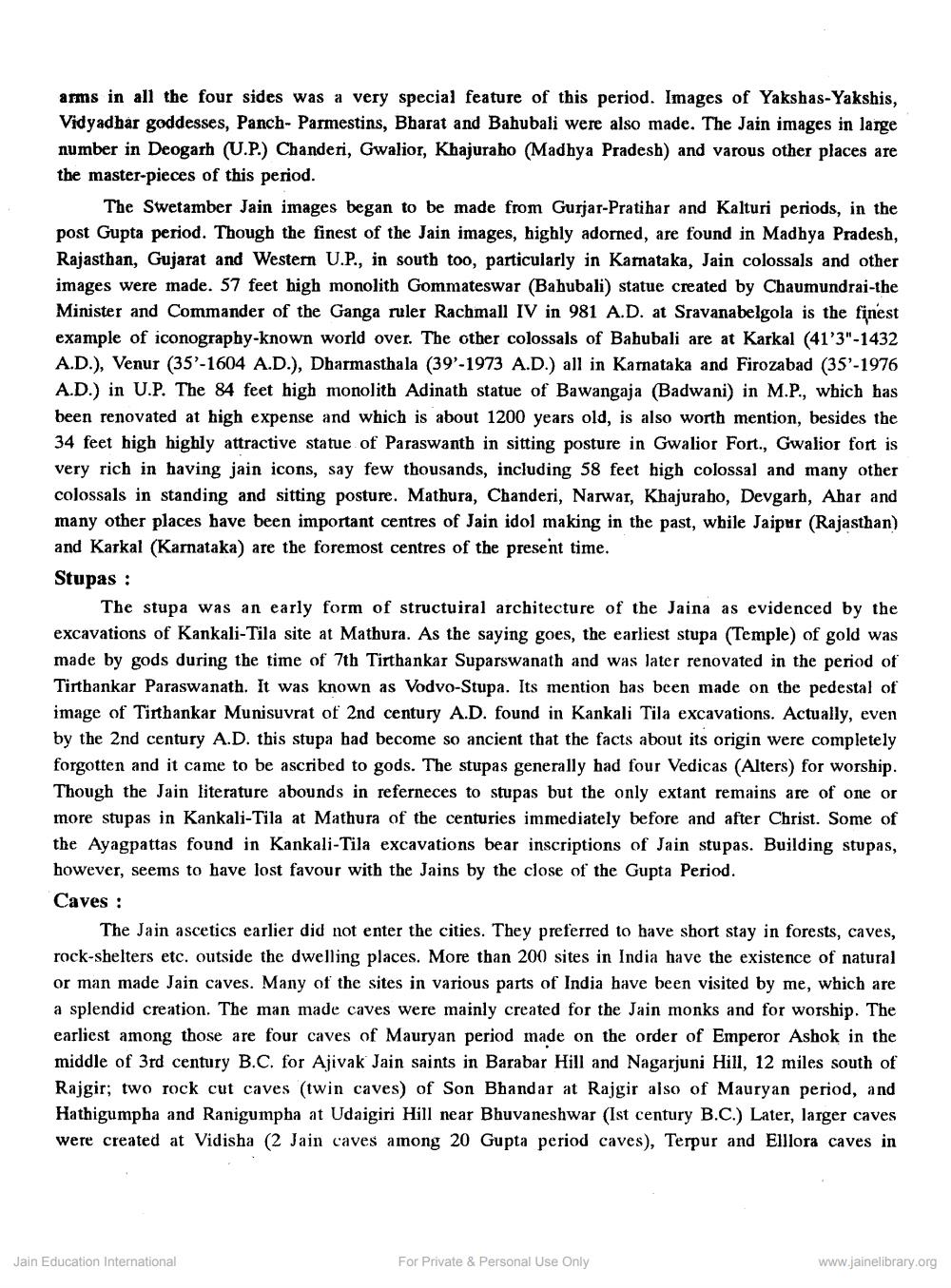________________
arms in all the four sides was a very special feature of this period. Images of Yakshas-Yakshis, Vidyadhar goddesses, Panch- Parmestins, Bharat and Bahubali were also made. The Jain images in large number in Deogarh (U.P.) Chanderi, Gwalior, Khajuraho (Madhya Pradesh) and varous other places are the master-pieces of this period.
The Swetamber Jain images began to be made from Gurjar-Pratihar and Kalturi periods, in the post Gupta period. Though the finest of the Jain images, highly adorned, are found in Madhya Pradesh, Rajasthan, Gujarat and Western U.P., in south too, particularly in Kamataka, Jain colossals and other images were made. 57 feet high monolith Gommateswar (Bahubali) statue created by Chaumundrai-the Minister and Commander of the Ganga ruler Rachmall IV in 981 A.D. at Sravanabelgola is the finest example of iconography-known world over. The other colossals of Bahubali are at Karkal (41'3"-1432 A.D.), Venur (35'-1604 A.D.), Dharmasthala (39'-1973 A.D.) all in Karnataka and Firozabad (35-1976 A.D.) in U.P. The 84 feet high monolith Adinath statue of Bawangaja (Badwani) in M.P., which has been renovated at high expense and which is about 1200 years old, is also worth mention, besides the 34 feet high highly attractive statue of Paraswanth in sitting posture in Gwalior Fort., Gwalior fort is very rich in having jain icons, say few thousands, including 58 feet high colossal and many other colossals in standing and sitting posture. Mathura, Chanderi, Narwar, Khajuraho, Devgarh, Ahar and many other places have been important centres of Jain idol making in the past, while Jaipur (Rajasthan) and Karkal (Karnataka) are the foremost centres of the present time.
Stupas :
The stupa was an early form of structuiral architecture of the Jaina as evidenced by the excavations of Kankali-Tila site at Mathura. As the saying goes, the earliest stupa (Temple) of gold was made by gods during the time of 7th Tirthankar Suparswanath and was later renovated in the period of Tirthankar Paraswanath. It was known as Vodvo-Stupa. Its mention has been made on the pedestal of image of Tirthankar Munisuvrat of 2nd century A.D. found in Kankali Tila excavations. Actually, even by the 2nd century A.D. this stupa had become so ancient that the facts about its origin were completely forgotten and it came to be ascribed to gods. The stupas generally had four Vedicas (Alters) for worship. Though the Jain literature abounds in referneces to stupas but the only extant remains are of one or more stupas in Kankali-Tila at Mathura of the centuries immediately before and after Christ. Some of the Ayagpattas found in Kankali-Tila excavations bear inscriptions of Jain stupas. Building stupas, however, seems to have lost favour with the Jains by the close of the Gupta Period.
Caves :
The Jain ascetics earlier did not enter the cities. They preferred to have short stay in forests, caves, rock-shelters etc. outside the dwelling places. More than 200 sites in India have the existence of natural or man made Jain caves. Many of the sites in various parts of India have been visited by me, which are a splendid creation. The man made caves were mainly created for the Jain monks and for worship. The earliest among those are four caves of Mauryan period made on the order of Emperor Ashok in the middle of 3rd century B.C. for Ajivak Jain saints in Barabar Hill and Nagarjuni Hill, 12 miles south of Rajgir; two rock cut caves (twin caves) of Son Bhandar at Rajgir also of Mauryan period, and Hathigumpha and Ranigumpha at Udaigiri Hill near Bhuvaneshwar (1st century B.C.) Later, larger caves were created at Vidisha (2 Jain caves among 20 Gupta period caves), Terpur and Elllora caves in
Jain Education International
For Private & Personal Use Only
www.jainelibrary.org




